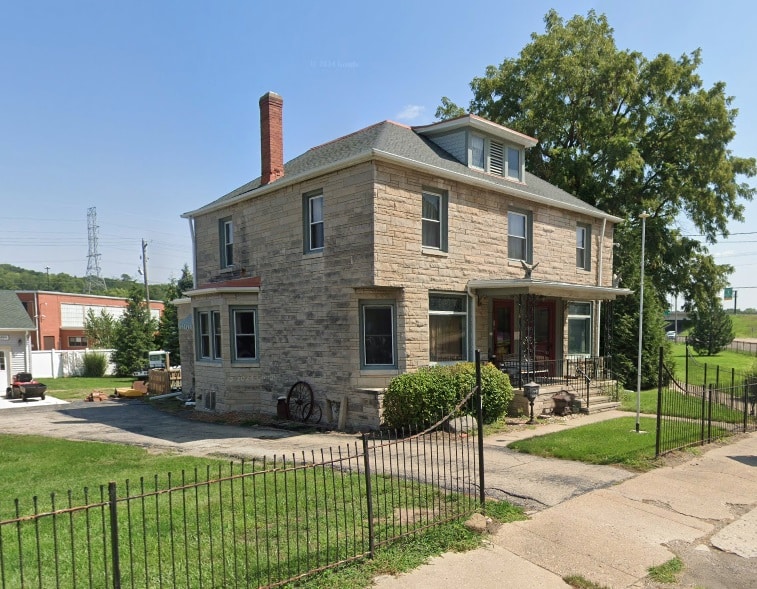This is a revised reprint of a “From the Local History Room” column that first appeared in August 2012 before the launch of this weblog.
Electric street lights have been a part of our lives for so long that most of us take them for granted. Nevertheless, the introduction of street lights in the latter half of the 1800s was a revolution in the way we live – and not uncommonly in a revolution, people can get hurt, as well shall learn in this week’s exploration of the Pekin Public Library’s Local History Room collection.
It was during the 1860s that street lights were installed in Pekin – but they were gas lights, not electric. Here is how the 1974 Pekin Sesquicentennial tells the story:
“It was February 18, 1861, when an Act to Incorporate the Pekin Gas Light Company was approved by the Illinois General Assembly. It was four years later, however, before said company was organized, with William Stansbury as president. . . It was under Stansbury, though, that the first gas street lights were put in operation, and the old lamp-lighter was a familiar figure in the city from February 5, 1866, until 1888, when electric street lights replaced the old gas type.”
William H. Bates in the 1887 Pekin City Directory also notes that, “On the 5th of February, 1866, the City Council ‘deemed it expedient and proper to light the streets, lanes, avenues and alleys of the city with gas.’”
The Sesquicentennial also tells of the founding of Pekin’s first electric utility companies in the late 1880s and early 1890s. The switch from gas to electric lights also meant a change in power sources. With gas lights, it was simply a matter of burning natural gas to give off light, but with electric lights the electricity must be generated.
In those early days, steam power was one of the means of power generation for electric street lights. Usually everything worked as it was supposed to, but one September day in Morton it resulted in tragedy.
Ben C. Allensworth’s 1905 “History of Tazewell County” includes accounts of various “Calamitous Events” that befell the residents of Tazewell County. One of them, related on page 82, is entitled, “Fatal Explosion at Morton.” Here is Allensworth’s account:
“A 5 o’clock, p.m., September 5, 1897, the steam-boiler of the electric light plant at Morton, blew up from some cause never ascertained. The building was a one and a half story brick, and was used as a feed-mill, pumping station for the water supply, and as a saw-mill. It was owned by Barr Bros. & Co. George Grimm, foreman, had just gone to his supper leaving a pressure of 25 pounds on the boiler, when the explosion took place. The boiler was blown through the roof, and brick, iron and debris were scattered for blocks around.
“Those killed were: Tillie Buyer, aged 5 years; Emma Buyer, aged 12 years; Albert Buyer, aged 4 years, who died next day.
“The injured were: Frank Buyer, aged 14 years, and Miss Cassie White, who was visiting friends in Morton at the time the explosion occurred. The children injured and killed belonged to the family of Moses Buyer. At the time of the explosion they were playing in the back yard, and at the first intimation of danger started for the house nearby, but were caught by the falling missiles and two of them were instantly killed.
“This was the most serious calamity that has ever befallen the village of Morton.”

In his account of this tragedy, Allensworth misspells the family name of the children who died or were injured. They were the children of Moses S. Beyer (1861-1933) and Susan (Zobrist) Beyer (1868-1922). Moses, an electrician, worked at the very plant that took the lives of three of his children when it exploded (and in fact, Allensworth’s “Barr Bros. & Co.” may be an error for “Beyer Bros. & Co.”). Emma, Tillie, and Albert Beyer are buried in the old Apostolic Christian Cemetery of Morton. Also buried with them is an unnamed infant of Moses and Susan who also died in 1897.
Besides their son Frank, U.S. Census records show that Moses and Susan had three other children, daughters named Mary, Lena, and Anna, who survived to mourn the loss of their siblings. Their mother Susan, severely traumatized by the loss of four of her children the same year, can also be counted as a victim of the disaster: census records show that by 1900 she was a patient living at the Peoria State Hospital near Bartonville, and remained there until her death on Oct. 16, 1922. She and Moses are buried together in Morton’s Apostolic Christian Cemetery.










